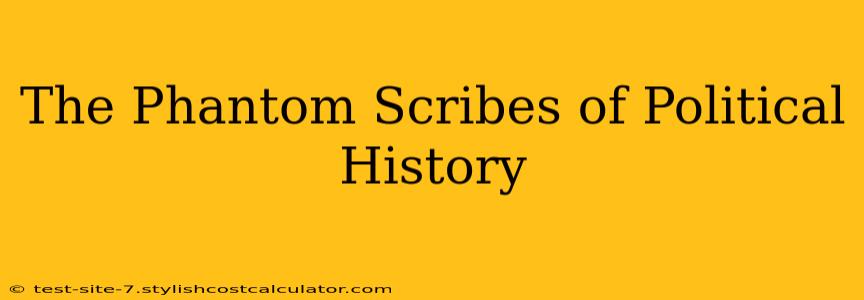Political history isn't just about the grand pronouncements of leaders or the momentous battles fought. It's also—and perhaps even more importantly—shaped by the unseen hands, the "phantom scribes," who craft the narratives that define the past and, in turn, influence the present. These are the individuals and groups who, through their writing, editing, censorship, and propaganda, mold public perception and shape our understanding of crucial political events. This exploration delves into the often-overlooked roles of these phantom scribes and their profound impact on political history.
Who are the Phantom Scribes?
The term "phantom scribes" encompasses a broad range of individuals and entities who manipulate or influence the historical record. They include:
-
Propagandists: Throughout history, governments and political movements have employed propagandists to shape public opinion, often by selectively presenting facts or creating outright falsehoods. The Nazi regime's masterful use of propaganda is a chilling example, as is the Soviet Union's control over information.
-
Censors: Those who suppress information, whether through direct censorship or subtle manipulation, profoundly alter the historical narrative. The deletion of inconvenient truths, the silencing of dissenting voices, and the control of archives all contribute to a skewed understanding of the past.
-
Historians with Biases: While historians strive for objectivity, their own perspectives, biases, and the context in which they write inevitably influence their work. Understanding these biases is crucial for a critical analysis of any historical account.
-
Editors and Publishers: The editorial process itself can significantly impact how history is presented. Decisions regarding which stories to cover, which voices to amplify, and even the language used can subtly shape the narrative. Powerful media outlets wield considerable influence in this respect.
-
Ghostwriters: Many powerful figures have relied on ghostwriters to craft their memoirs, speeches, and other public statements. These ghostwriters often have a significant, albeit hidden, hand in shaping the public perception of these figures.
How Do Phantom Scribes Shape Narratives?
The methods employed by phantom scribes are diverse and often subtle:
-
Selective Presentation of Facts: Focusing on certain events while ignoring others creates a biased narrative. This selective approach can be used to glorify certain figures or movements while demonizing others.
-
Manufacturing Consent: Through carefully crafted messaging, phantom scribes can create a consensus around a particular version of events, even if that version is inaccurate or incomplete.
-
Controlling Access to Information: Restricting access to archives, suppressing dissenting viewpoints, and controlling the flow of information are potent tools for shaping public perception.
-
Framing and Language: The choice of words and the framing of events can significantly alter their meaning. Negative or positive connotations can be subtly woven into the narrative to influence the reader's interpretation.
What are some examples of phantom scribes throughout history?
Numerous examples illustrate the power of phantom scribes. The carefully curated image of Stalin in the Soviet Union, the propaganda machine of Nazi Germany, and even the selective editing of historical accounts in various nations exemplify this influence. The ongoing debate surrounding the historical narratives of colonialism and its impact highlight the continuing power of these unseen influencers.
How can we identify and counteract the influence of phantom scribes?
Identifying the influence of phantom scribes requires critical thinking and a multi-faceted approach:
-
Source Verification: Carefully examine the sources used in historical accounts and assess their potential biases.
-
Cross-referencing Information: Compare accounts from multiple sources to gain a more comprehensive understanding of events.
-
Considering Context: Analyze the historical context in which a narrative was created and understand the potential influences at play.
-
Seeking Diverse Perspectives: Engage with diverse perspectives and interpretations of historical events to challenge prevailing narratives.
What are some techniques for critically evaluating historical narratives?
Critical evaluation of historical narratives involves scrutinizing the sources, identifying biases, and considering alternative interpretations. This requires analytical skills and a willingness to challenge established narratives. By employing a critical lens, we can begin to identify and understand the influence of phantom scribes and build a more accurate and nuanced understanding of political history.
By understanding the role of phantom scribes, we can move towards a more informed and accurate interpretation of political history, fostering critical thinking and a more nuanced understanding of the past. Their influence, while often unseen, is profound and deserves careful consideration. The quest for historical truth requires a constant vigilance against the subtle manipulations of these hidden hands.

